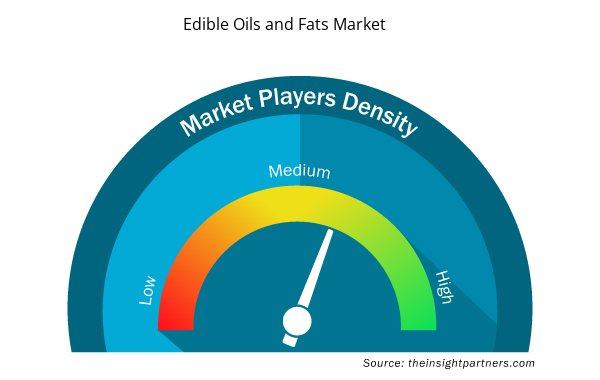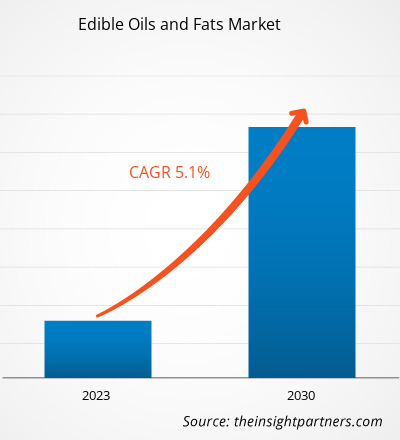[研究报告] 食用油脂市场预计将从 2022 年的 529.2 亿美元增长到 2030 年的 786.8661 亿美元;预计 2023 年至 2030 年的复合年增长率为 5.1%。
市场洞察和分析师观点:
食用脂肪是通过动物源性原料(如猪油和牛脂)或植物源性原料获得的。肉类加工商是食用动物源性脂肪制造商的原材料供应商。制造商与肉类加工行业签订了长期协议,以获得不间断的原材料供应。将猪肉或牛肉的脂肪组织切成小块,在蒸汽蒸煮器中煮沸,脂肪被释放到水中。脂肪漂浮在水面上,通过撇渣收集。将动物组织的膜状物质放入液压机中压制,从而获得额外的脂肪。在除渣离心机中将脂肪从液相中分离出来。
人造黄油等植物油脂是通过对大豆油、玉米油或红花油进行氢化而获得的。首先用漂白土或木炭对油进行漂白,以去除不良气味和颜色。然后将其通过高压氢气,使油凝固以获得人造黄油。制造植物油和脂肪的工艺多种多样。
精炼食用油脂经包装后,通过分销商和供应商送往食品饮料、动物营养、医药和保健品等终端用户。嘉吉公司、邦吉有限公司、ADM、富士制油株式会社和花王株式会社是全球主要的食用油脂制造商。
增长动力和挑战:
根据美国农业部 (USDA) 的数据,大豆油是第二大消费植物油。它广泛用于煎炸、烹饪、起酥油和人造黄油。根据经济合作与发展组织 (OECD) 的数据,2022 年,植物油消费量达到 2.49 亿公吨,其中食品行业占主要份额。此外,糖果行业大量使用黄油作为主要成分,其次是人造黄油。高品质食用油和脂肪用于烘焙和糖果、乳制品和冷冻甜点、零食、即食 (RTE) 和即食 (RTC) 餐以及其他食品和饮料。精炼油和脂肪是脂质的丰富来源。因此,由于应用的增加和全球人口的增长,它们的使用量正在增加。
由于人们对可持续性的倾向日益高涨、对便利和即食产品的偏好以及对有机和植物性产品的采用日益增加,北美和亚太等不同地区的食品和饮料行业正在持续增长。该行业正在见证流程、产品和服务创新的重大进展,以满足快速变化的消费者偏好。根据美国人口普查局的数据,2020 年美国拥有 39,646 家食品和饮料制造厂。其中加利福尼亚州、德克萨斯州和纽约州分别有 6,116 家、2,625 家和 2,600 家。同样,食品和饮料行业是欧洲经济的重要贡献者之一。因此,全球食品和饮料行业的蓬勃发展推动了对食用油脂的需求。
定制此报告以满足您的需求
您可以免费定制任何报告,包括本报告的部分内容、国家级分析、Excel 数据包,以及为初创企业和大学提供优惠和折扣
- 获取此报告的关键市场趋势。这个免费样品将包括数据分析,从市场趋势到估计和预测。
报告细分和范围:
“全球食用油脂市场”按类型、应用和地域进行细分。根据类型,市场分为油脂。根据应用,全球食用油脂分为食品和饮料、动物营养、药品和营养保健品。石油部门在全球占有较大份额
食用油脂市场
2022 年。根据地理位置,食用油脂市场细分为北美(美国、加拿大和墨西哥)、欧洲(德国、法国、意大利、英国、俄罗斯和欧洲其他地区)、亚太地区(澳大利亚、中国、日本、印度、韩国和亚太其他地区)、中东和非洲(南非、沙特阿拉伯、阿联酋和中东和非洲其他地区)以及南美洲和中美洲(巴西、智利和南美洲和中美洲其他地区)。
节段分析:
根据类型,食用油脂市场分为油脂和油。 2022 年,油类部分占据了食用油脂市场的更大份额,预计在预测期内将实现更高的复合年增长率。植物油可以从种子、谷物、坚果和水果中提取。 橄榄油、葵花籽油、棕榈油、菜籽油、椰子油、红花油、玉米油、花生油、棉籽油、棕榈仁油和大豆油是消费最多的油。 通常,植物油用于食品制备,并添加原油以增加风味。 植物油也用于生产动物饲料。 棕榈油易于稳定,可在加工食品中保持风味质量和一致性。 因此,它们经常受到食品制造商的青睐。 印度尼西亚、马来西亚、泰国和尼日利亚是最大的棕榈油生产国和出口国。 人们对氢化植物油中反式脂肪相关的健康问题的认识不断提高,推动了棕榈油在食品工业中的使用。农业食品行业是棕榈油的重要消费者,因为它主要用于工业烘焙食品、巧克力产品、糖果、冰淇淋,甚至减肥餐替代品。棕榈油富含生育酚和类胡萝卜素,可赋予其天然的抗氧化稳定性。因此,棕榈油在各种终端行业中的优势和应用推动了其在世界各地的需求。
区域分析:
食用油脂市场分为五个主要区域——北美、欧洲、亚太地区、南美和中美以及中东和非洲。全球食用油脂市场以南美和中美为主,预计 2022 年将达到约 45,000 亿美元。南美和中美的食用油脂市场分为巴西、阿根廷和南美和中美其他地区。由于消费者对冷冻零食、咸味零食、水果零食、糖果零食和烘焙零食等不同零食选择的偏好日益增加,该地区的零食行业正在扩大。食用油脂起着不可或缺的作用,因为它们为食物提供独特的风味,并在制造零食方面提供独特和理想的功能。例如,油是油炸食品的煎炸介质,在糕点中,添加植物油基起酥油以防止面粉和其他成分结块。因此,对不同零食的需求不断增长以及食用油脂相关的好处推动了南美和中美洲零食行业对食用油脂的需求。
此外,南美洲和中美洲动物营养等终端行业对食用油脂的需求有所增加。据《石油世界》报道,2022 年,中国购买了巴西约 70% 的大豆油,主要用于动物蛋白消费。此外,不断扩大的动物营养、制药和营养保健品行业推动了对专用食用油脂的需求。这些行业需要特定类型的油用于各种应用,例如动物饲料配方和药物配方。随着这些行业的增长和多样化,对其独特需求的需求也在增加,从而推动了南美洲和中美洲食用油脂市场的增长。
行业发展和未来机遇:
全球食用油脂市场主要参与者采取的各种举措如下:
- 2021年10月,美国著名食用油脂制造商之一ADM宣布,计划在北达科他州建设首个专用大豆压榨厂和精炼厂,以满足食品和动物饲料行业对大豆油快速增长的需求。
- 2021年12月,总部位于日本的伊藤忠商事株式会社宣布,通过总部位于美国纽约的伊藤忠国际株式会社,在美国成立不二制油国际有限公司。通过此项协议,该公司计划加强在北美的油脂业务。
食用油脂市场区域洞察
Insight Partners 的分析师已详细解释了预测期内影响食用油脂市场的区域趋势和因素。本节还讨论了北美、欧洲、亚太地区、中东和非洲以及南美和中美洲的食用油脂市场细分和地理位置。

- 获取食用油脂市场的区域特定数据
食用油脂市场报告范围
| 报告属性 | 细节 |
|---|---|
| 2022 年市场规模 | 529.2亿美元 |
| 2030 年的市场规模 | 786.9 亿美元 |
| 全球复合年增长率(2022 - 2030 年) | 5.1% |
| 史料 | 2020-2021 |
| 预测期 | 2023-2030 |
| 涵盖的领域 | 按类型
|
| 覆盖地区和国家 | 北美
|
| 市场领导者和主要公司简介 |
|
市场参与者密度:了解其对商业动态的影响
食用油脂市场正在快速增长,这得益于消费者偏好的不断变化、技术进步以及对产品益处的认识不断提高等因素导致的终端用户需求不断增加。随着需求的增加,企业正在扩大其产品范围,进行创新以满足消费者的需求,并利用新兴趋势,从而进一步推动市场增长。
市场参与者密度是指在特定市场或行业内运营的企业或公司的分布情况。它表明在给定市场空间中,相对于其规模或总市场价值,有多少竞争对手(市场参与者)存在。
在食用油脂市场运营的主要公司有:
- 邦吉公司
- 阿彻丹尼尔斯米德兰公司
- 不二制油株式会社
- 花王公司
- 安克公司
免责声明:上面列出的公司没有按照任何特定顺序排列。

- 获取食用油和脂肪市场顶级关键参与者概述
COVID-19 疫情影响:
COVID-19 疫情影响了各国的经济和行业。北美、欧洲、亚太地区 (APAC)、南美和中美以及中东和非洲 (MEA) 主要国家的封锁、旅行禁令和企业停工对包括食品和饮料行业在内的各行业的增长产生了负面影响。制造部门的关闭扰乱了全球供应链、制造活动、交付计划以及各种必需品和非必需品的销售。多家公司宣布,2020 年产品交付可能会延迟,未来产品销售将出现下滑。此外,欧洲、亚洲和北美各国政府对国际旅行实施的禁令迫使各公司暂时搁置合作和伙伴关系计划。所有这些因素都阻碍了 2020 年和 2021 年初的食品和饮料行业,从而抑制了食用油脂市场的增长。
竞争格局和重点公司:
邦吉有限公司、阿彻丹尼尔斯米德兰公司、富士制油有限公司、花王公司、AAK AB、J-Oil Mills Inc、嘉吉公司、奥兰集团有限公司、ConnOils LLC 和路易达孚公司是全球食用油脂市场的知名企业。这些食用油脂制造商提供具有创新功能的尖端萃取解决方案,为消费者带来卓越的体验。
- 历史分析(2 年)、基准年、预测(7 年)及复合年增长率
- PEST 和 SWOT 分析
- 市场规模价值/数量 - 全球、区域、国家
- 行业和竞争格局
- Excel 数据集


- Authentication and Brand Protection Market
- Electronic Toll Collection System Market
- Foot Orthotic Insoles Market
- Passport Reader Market
- Molecular Diagnostics Market
- Wire Harness Market
- Mobile Phone Insurance Market
- Aesthetic Medical Devices Market
- Battery Testing Equipment Market
- Identity Verification Market

Report Coverage
Revenue forecast, Company Analysis, Industry landscape, Growth factors, and Trends

Segment Covered
This text is related
to segments covered.

Regional Scope
North America, Europe, Asia Pacific, Middle East & Africa, South & Central America

Country Scope
This text is related
to country scope.
常见问题
Manufacturers of edible fats and oils invest significantly in the expansion of business and production capacity to serve their customer base better and meet their consumer requirements. In December 2021, ITOCHU Corporation, headquartered in Japan, announced their agreement through ITOCHU International Inc., headquartered in New York, US, for the establishment of Fuji Oil International Inc. in the US. With this agreement, the firm plans to strengthen the oil and fat business in North America.
Based on type, oil segment mainly has the largest revenue share. Vegetable oils can be derived from seeds, cereal grains, nuts, and fruits. The most consumed oils are olive, sunflower, palm, canola, coconut, safflower, corn, peanut, cottonseed, palm kernel, and soybean. Generally, vegetable oils are used in food preparation, and crude oil is added for flavor. Vegetable oil is also used in the production of animal feed.
The major players operating in the global edible oils and fats market are are Bunge Ltd, Archer-Daniels-Midland Co, Fuji Oil Co Ltd, Kao Corp, AAK AB, J-Oil Mills Inc, Cargill Inc, Olam Group Ltd, ConnOils LLC, and Louis Dreyfus Co BV.
Consumers consider plant-based products healthier than conventional products. Rising health consciousness among consumers propels the demand for plant-based and low-fat products. Thus, manufacturers develop plant-based shortenings and low-fat oils to cater to the rising demand. Plant-based shortenings are non-hydrogenated and do not contain cholesterol and trans-fat. Thus, it is considered a healthier alternative to conventional shortenings. Moreover, the increasing prevalence of cardiovascular diseases, obesity, and diabetes over the years is expected to boost the demand for low-fat products such as low-fat oils among various industries, including bakery & confectioneries, dairy & frozen desserts, and snacking.
Asia Pacific accounted for the largest share of the global edible oils and fats market. The market growth is attributed to increasing demand for bakery products, especially breads, cakes, pastries, and muffins, coupled with the growing influence of Western culture on the millennial and Gen-z population in the region. The bakery sector in China witnessed tremendous growth, with retail sales of bakery products accounting for US$ 34 billion in 2020, according to the United States Department of Agriculture (USDA). Moreover, manufacturers of edible oils and fats actively operate across the region and offer edible oils and fats made with fine-quality oil or its fractions. Distinct melting profiles of butter and margarines, packaging types, and the expansion of antifoaming or antioxidant agents of edible oils and fats are available across the region and widely applicable in many end-use industries such as confectionery, bakery, dairy, and infant nutrition.
Based on the application, food and beverages segment is hold a significant share in the market. The demand for edible oils and fats, such as shortenings, is gradually increasing in bakery and confectionery segment as they lubricate the structure of bakery products and shorten or tender flour proteins. Fats and oils in the mixture hold many air cells incorporated during creaming, making the products smooth and creamy. Fats act as enriching agents, add calorie value to baked foods, and develop flakiness in products. The rising demand for baked products, including cakes, breads, cookies, and biscuits, significantly drives edible oils and fats utilization.
Trends and growth analysis reports related to Food and Beverages : READ MORE..
The List of Companies - Edible Oils and Fats Market
- Bunge Ltd
- Archer-Daniels-Midland Co
- Fuji Oil Co Ltd
- Kao Corp
- AAK AB
- J-Oil Mills Inc
- Cargill Inc
- Olam Group Ltd
- ConnOils LLC
- Louis Dreyfus Co BV
The Insight Partners performs research in 4 major stages: Data Collection & Secondary Research, Primary Research, Data Analysis and Data Triangulation & Final Review.
- Data Collection and Secondary Research:
As a market research and consulting firm operating from a decade, we have published and advised several client across the globe. First step for any study will start with an assessment of currently available data and insights from existing reports. Further, historical and current market information is collected from Investor Presentations, Annual Reports, SEC Filings, etc., and other information related to company’s performance and market positioning are gathered from Paid Databases (Factiva, Hoovers, and Reuters) and various other publications available in public domain.
Several associations trade associates, technical forums, institutes, societies and organization are accessed to gain technical as well as market related insights through their publications such as research papers, blogs and press releases related to the studies are referred to get cues about the market. Further, white papers, journals, magazines, and other news articles published in last 3 years are scrutinized and analyzed to understand the current market trends.
- Primary Research:
The primarily interview analysis comprise of data obtained from industry participants interview and answers to survey questions gathered by in-house primary team.
For primary research, interviews are conducted with industry experts/CEOs/Marketing Managers/VPs/Subject Matter Experts from both demand and supply side to get a 360-degree view of the market. The primary team conducts several interviews based on the complexity of the markets to understand the various market trends and dynamics which makes research more credible and precise.
A typical research interview fulfils the following functions:
- Provides first-hand information on the market size, market trends, growth trends, competitive landscape, and outlook
- Validates and strengthens in-house secondary research findings
- Develops the analysis team’s expertise and market understanding
Primary research involves email interactions and telephone interviews for each market, category, segment, and sub-segment across geographies. The participants who typically take part in such a process include, but are not limited to:
- Industry participants: VPs, business development managers, market intelligence managers and national sales managers
- Outside experts: Valuation experts, research analysts and key opinion leaders specializing in the electronics and semiconductor industry.
Below is the breakup of our primary respondents by company, designation, and region:

Once we receive the confirmation from primary research sources or primary respondents, we finalize the base year market estimation and forecast the data as per the macroeconomic and microeconomic factors assessed during data collection.
- Data Analysis:
Once data is validated through both secondary as well as primary respondents, we finalize the market estimations by hypothesis formulation and factor analysis at regional and country level.
- Macro-Economic Factor Analysis:
We analyse macroeconomic indicators such the gross domestic product (GDP), increase in the demand for goods and services across industries, technological advancement, regional economic growth, governmental policies, the influence of COVID-19, PEST analysis, and other aspects. This analysis aids in setting benchmarks for various nations/regions and approximating market splits. Additionally, the general trend of the aforementioned components aid in determining the market's development possibilities.
- Country Level Data:
Various factors that are especially aligned to the country are taken into account to determine the market size for a certain area and country, including the presence of vendors, such as headquarters and offices, the country's GDP, demand patterns, and industry growth. To comprehend the market dynamics for the nation, a number of growth variables, inhibitors, application areas, and current market trends are researched. The aforementioned elements aid in determining the country's overall market's growth potential.
- Company Profile:
The “Table of Contents” is formulated by listing and analyzing more than 25 - 30 companies operating in the market ecosystem across geographies. However, we profile only 10 companies as a standard practice in our syndicate reports. These 10 companies comprise leading, emerging, and regional players. Nonetheless, our analysis is not restricted to the 10 listed companies, we also analyze other companies present in the market to develop a holistic view and understand the prevailing trends. The “Company Profiles” section in the report covers key facts, business description, products & services, financial information, SWOT analysis, and key developments. The financial information presented is extracted from the annual reports and official documents of the publicly listed companies. Upon collecting the information for the sections of respective companies, we verify them via various primary sources and then compile the data in respective company profiles. The company level information helps us in deriving the base number as well as in forecasting the market size.
- Developing Base Number:
Aggregation of sales statistics (2020-2022) and macro-economic factor, and other secondary and primary research insights are utilized to arrive at base number and related market shares for 2022. The data gaps are identified in this step and relevant market data is analyzed, collected from paid primary interviews or databases. On finalizing the base year market size, forecasts are developed on the basis of macro-economic, industry and market growth factors and company level analysis.
- Data Triangulation and Final Review:
The market findings and base year market size calculations are validated from supply as well as demand side. Demand side validations are based on macro-economic factor analysis and benchmarks for respective regions and countries. In case of supply side validations, revenues of major companies are estimated (in case not available) based on industry benchmark, approximate number of employees, product portfolio, and primary interviews revenues are gathered. Further revenue from target product/service segment is assessed to avoid overshooting of market statistics. In case of heavy deviations between supply and demand side values, all thes steps are repeated to achieve synchronization.
We follow an iterative model, wherein we share our research findings with Subject Matter Experts (SME’s) and Key Opinion Leaders (KOLs) until consensus view of the market is not formulated – this model negates any drastic deviation in the opinions of experts. Only validated and universally acceptable research findings are quoted in our reports.
We have important check points that we use to validate our research findings – which we call – data triangulation, where we validate the information, we generate from secondary sources with primary interviews and then we re-validate with our internal data bases and Subject matter experts. This comprehensive model enables us to deliver high quality, reliable data in shortest possible time.


 获取此报告的免费样本
获取此报告的免费样本